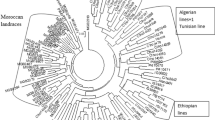Summary
Data from the electrophoretic assay for seven enzyme loci of 1,032 accessions of cultivated barley, Hordeum vulgare L., from the USDA world barley collection were analyzed for multilocus structure using discrete log-linear multivariate techniques. Three major steps were involved in the analysis: (i) identification and elimination of terms that have inconsequential effects in multilocus association; (ii) construction of a log-linear model that best describes the complete multilocus structure of the genetic system; and (iii) evaluation of each of the association terms included in the model. The results of analyses of two subsets of loci show that the multilocus genetic system of cultivated barley, including loci located on different chromosomes, is organized into hierarchically structured complexes of loci. Multilocus structure differs in various geographical regions of the world. The structure of barleys from Southwest Asia, the putative center of origin for cultivated barley, is intermediate for both subsets of loci. Differences increased progressively across the Eurasian-African landmasses in each direction with increasing distance from Southwest Asia, with the consequence that the barleys from West Europe, East Asia, and Ethiopia are maximally different from those of Southwest Asia and Middle South Asia.
Similar content being viewed by others
References
Allard RW (1988) Genetic changes associated with the evolution of adaptedness in cultivated plants and their wild progenitors. J Hered 79:225–238
Bennett JH (1954) On the theory of random mating. Ann Eugen 18:311–317
Brown AHD, Feldman M, Nevo E (1980) Multilocus structure of natural populations of Hordeum spontaneum. Genetics 96:523–536
Brown MB (1976) Screening effects in multidimensional contingency tables. Appl Stat 25:37–46
Clegg MT (1978) Dynamics of correlated genetic system. II. Simulation studies of chromosomal segments under selection. Theor Popul Biol 13:1–23
Clegg MT, Allard RW, Kahler AL (1972) Is the gene the unit of selection? Evidence from two experimental plant populations. Proc Natl Acad Sci USA 69:2474–2479
Fienberg SE (1980) The analysis of cross-classified categorical data. MIT Press, Cambridge/MA
Geiringer H (1944) On the probability theory of linkage in Mendelian heredity. Ann Math Stat 15:27–57
Goodman LA (1971) The analysis of multidimensional contingency tables: stepwise procedures and direct estimation methods for building models for multiple classification. Technometrics 13:33–61
Harlan JR (1979) On the origin of barley. In: Barley: origin, botany, culture, winter hardiness, genetics, utilization, pests. USDA-SEA Agricultural Handbook No. 338, Washington/DC, pp 10–36
Harlan JR, Zohary D (1966) Distribution of wild wheats and barley. Science 153:1074–1080
Hill WG (1974) Disequilibrium among several linked neutral genes in finite populations. I. Mean changes in disequilibrium. Theor Popul Biol 5:366–392
Hill WG (1975) Tests for association of gene frequencies at several loci in random mating diploid populations. Biometrics 31:881–888
Jana S, Zhang Q, Saghai Maroof MA (1989) Influence of environments on the development of multivariate structures in a barley composite cross at three locations. Genome 32:40–45
Kahler AL, Allard RW (1970) Genetics of isozyme variants in barley. I. Esterases. Crop Sci 10:444–448
Kahler AL, Allard RW (1981) Worldwide patterns of genetic variation among four esterase loci in barley (Hordeum vulgare L.). Theor Appl Genet 59:101–111
Kahler AL, Heath-Pagliuso S, Allard RW (1981) Genetics of isozyme variants in barley. II. 6-phosphogluconate dehydrogenase, glutamate oxalate transaminase, and acid phosphatase. Crop Sci 21:536–540
Soliman KM, Allard RW (1989) Chromosome locations of additional barley enzyme loci identified using wheat-barley addition lines. Plant Breed 102:177–181
Smouse P (1974) Likelihood analysis of recombinational disequilibrium and multiple-locus genetic frequencies. Genetics 76:557–565
Ward DJ (1962) Some evolutionary aspects of certain morphologic characters in a world collection of barley. USDA Tech Bull 1276:1–112
Weir BS, Allard RW, Kahler AL (1972) Analysis of complex allozyme polymorphisms in a barley population. Genetics 72:505–523
Weir BS, Allard RW, Kahler AL (1974) Further analysis of complex allozyme polymorphisms in a barley population. Genetics 78:911–919
Weir BS, Cockerham CC (1978) Testing hypothesis about linkage disequilibrium with multiple alleles. Genetics 88:633–642
Wright S (1933) Inbreeding and recombination. Proc Natl Acad Sci USA 19:420–433
Zouros E, Golding GB, Mackay TFC (1977) The effect of combining alleles on detecting linkage disequilibrium. Genetics 85:545–556
Author information
Authors and Affiliations
Additional information
Communicated by H. F. Linskens
Rights and permissions
About this article
Cite this article
Zhang, Q., Saghai Maroof, M.A. & Allard, R.W. Worldwide pattern of multilocus structure in barley determined by discrete log-linear multivariate analyses. Theoret. Appl. Genetics 80, 121–128 (1990). https://doi.org/10.1007/BF00224025
Received:
Accepted:
Issue Date:
DOI: https://doi.org/10.1007/BF00224025




